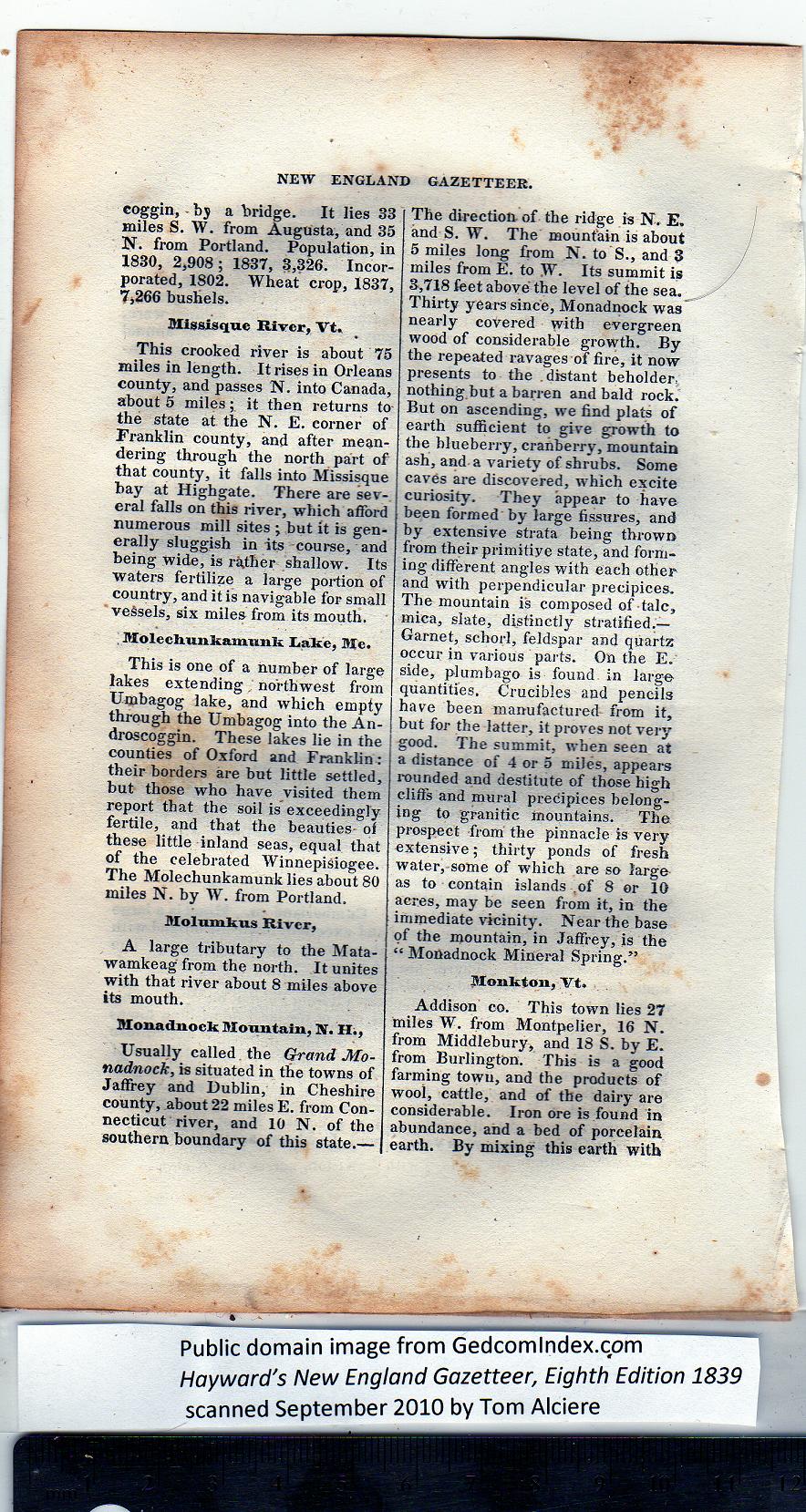|
coggin, by a bridge. It lies 33
miles S. W. from Augusta, and 35
N. from Portland. Population, in
1830, 2,908 ; 1837, 3,326. Incor-
porated, 1802. Wheat crop, 1837,
7S266 bushels.
Missisque River, Vt.
This crooked river is about 75
miles in length. It rises in Orleans
county, and passes N. into Canada,
about 5 miles; it then returns to
the state at the N. £. corner of
Franklin county, and after mean-
dering through the north part of
that county, it falls into Missisque
bay at Highgate. There are sev-
eral falls on this river, which afford
numerous mill sites ; but it is gen-
erally sluggish in its course, and
being wide, is rather shallow. Its
waters fertilize a large portion of
country, and it is navigable for small
vessels, six miles from its mouth.
Molechunkamunk Bake, Me.
This is one of a number of large
lakes extending northwest from
Umbagog lake, and which empty
through the Umbagog into the An-
droscoggin. These lakes lie in the
counties of Oxford and Franklin:
their borders are but little settled,
but those who have visited them
report that the soil is exceedingly
fertile, and that the beauties- of
these little inland seas, equal that
of the celebrated Winnepisiogee.
The Molechunkamunk lies about 80
miles N. by W. from Portland.
Molurakus River,
A large tributary to the Mata-
wamkeag from the north. It unites
with that river about 8 miles above
its mouth.
Monadnock Mountain, N. H.,
Usually called tbe Grand Mo-
nadnock, is situated in the towns of
Jaffrey and Dublin, in Cheshire
county, about 22 miles E. from Con-
necticut river, and 10 N. of the
southern boundary of this state.— |
The direction of the ridge is N. E.
and S. W. The mountain is about
5 miles long from N. to S., and 3
miles from E. to W. Its summit is
3,718 feet above the level of the sea.
Thirty years since, Monadnock was
nearly covered with evergreen
wood of considerable growth. By
the repeated ravages of fire, it now
presents to the distant beholder
nothing but a barren and bald rock.
But on ascending, we find plats of
earth sufficient to give growth to
the blueberry, cranberry, mountain
ash, and a variety of shrubs. Some
caves are discovered, which excite
i curiosity. They appear to have
been formed by large fissures, and
by extensive strata being thrown
from their primitiye state, and form-
ing different angles with each other
and with perpendicular precipices.
The mountain is composed of talc,
mica, slate, distinctly stratified.—
Garnet, schorl, feldspar and quartz
occur in various parts. On the E.
side, plumbago is found in large
quantities. Crucibles and pencils
have been manufactured from it,
but for the latter, it proves not very
good. The summit, when seen at
a distance of 4 or 5 miles, appears
rounded and destitute of those high
cliffs and mural precipices belong-
ing to granitic mountains. The
prospect from the pinnacle is very
extensive; thirty ponds of fresh
water, some of which are so large
as to contain islands .of 8 or 10
acres, may be seen from it, in the
immediate vicinity. Near the base
of the mountain, in Jaffrey, is the
“ Monadnock Mineral Spring.”
Mosikton, Vt.
Addison co. This town lies 27
miles W. from Montpelier, 16 N.
from Middlebury, and 18 S. by E.
from Burlington. This is a good
farming town, and the products of
wool, cattle, and of the dairy are
considerable. Iron ore is found in
abundance, and a bed of porcelain
earth. By mixing this earth with |
